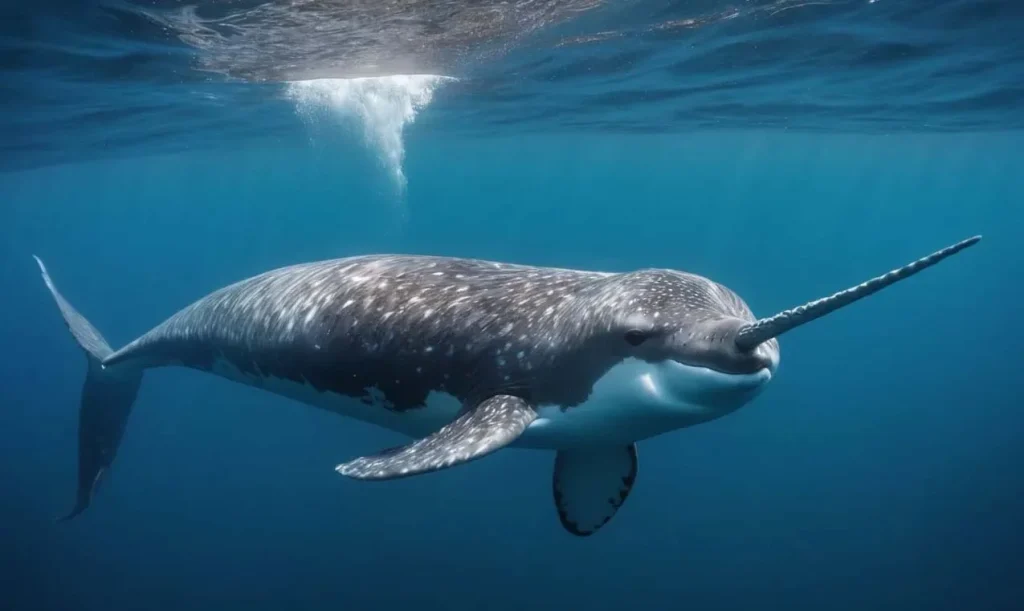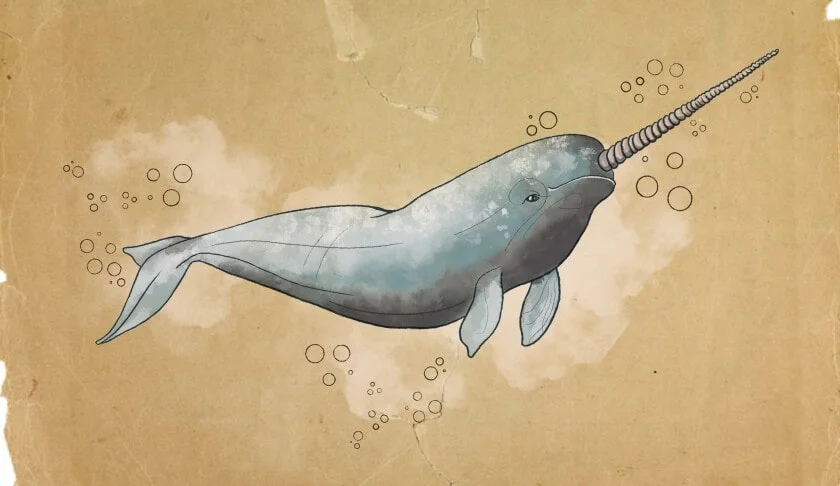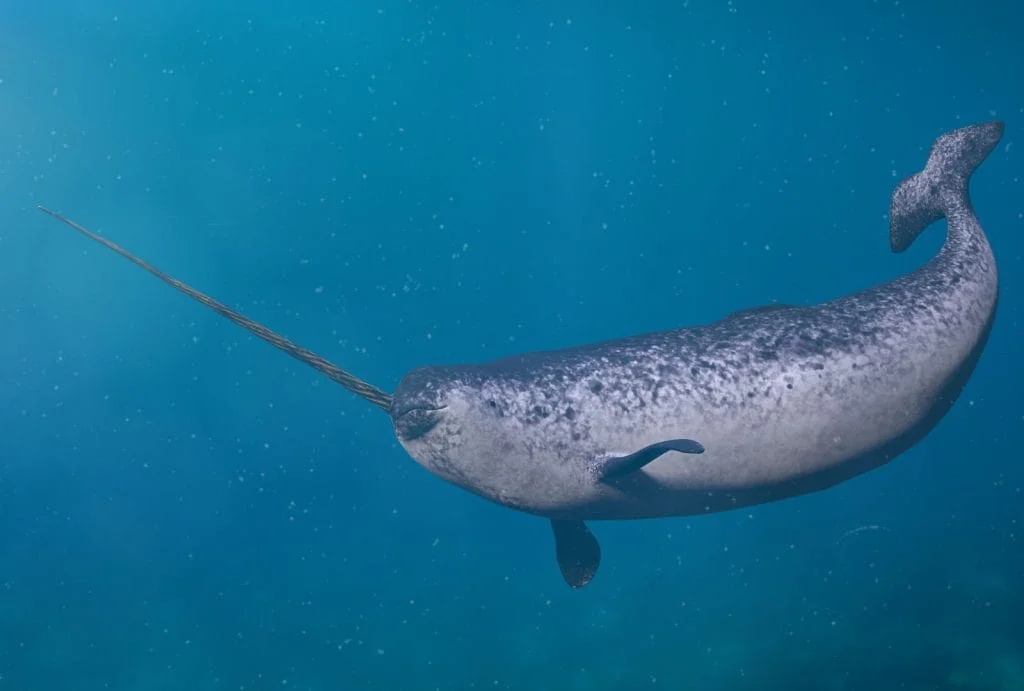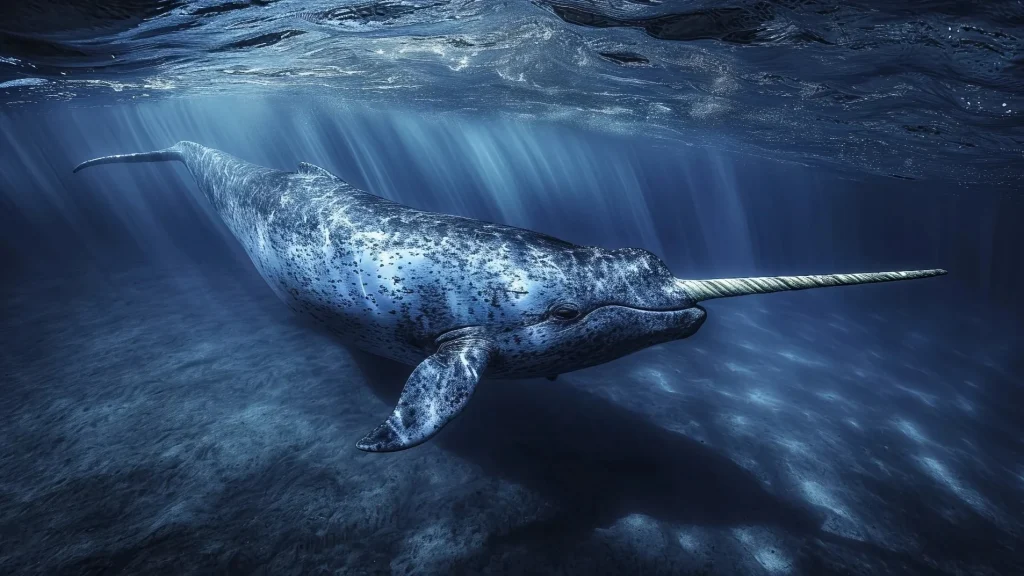Have you ever wondered about the unicorns of the sea? Narwhals, with their iconic spiraled tusks, roam the icy waters of the Arctic like mythical creatures from a fairy tale. These remarkable marine mammals lead lives full of mysteries and marvels that often go unnoticed.
Why do they have such long tusks? What secrets do the depths of the Arctic hold about these elusive beings? Join us as we dive into the enchanting world of narwhals with some fascinating facts that reveal their hidden lives and extraordinary behaviors.
The narwhal, with its single tusk, is the unicorn of the ocean.
Sylvia Earle
Narwhal Facts
Before you explore the depths of narwhal mysteries, read carefully. A quiz awaits at the end of this article to challenge your expertise.
- Their tusk is actually an elongated upper left canine tooth that spirals counter-clockwise.
- These marine creatures can dive deeper than 1,500 meters, which is more than three times the height of the Eiffel Tower.
- Their tusks have up to 10 million nerve endings, potentially making them highly sensitive tools.
- They primarily feed on Arctic species like Greenland halibut, Arctic cod, and shrimp.
- Climate change impacts them significantly, altering their habitat by reducing sea ice.
- The “unicorn of the sea” can live up to 50 years.
- Inuit communities legally hunt them as a source of fat, skin, meat, and tusks.
- Female tusks are rare and generally smaller if they develop.
- They use echolocation to navigate and find food in the dark, murky waters of the Arctic.
- These animals travel in groups called pods, which can contain as many as several dozen individuals.
- Their skin, referred to as muktuk, is rich in vitamin C and consumed as a traditional food.
- The longest recorded tusk was over 2.6 meters long.
- Unlike most other marine mammals, they do not have a dorsal fin, which is an adaptation to ice-covered waters.

- Legendary explorers once believed the tusks were unicorn horns with magical powers.
- They are capable of changing their vocal sounds to communicate different messages.
- Young calves have a mottled gray coloration that darkens with age.
- Historically, their tusks were so valuable in Europe that they were worth 10 times their weight in gold.
- They have been observed using their tusks to stun fish before eating them.
- Their closest relative is the Beluga whale, and they often share habitats.
- Sonar and satellite technology are now being used to study their migration patterns more effectively.
- They make a wide variety of sounds, which include clicks, whistles, and knocks for communication.
- The thickness of the ice where they live can reach up to several meters, affecting their access to breathing holes.
- During the summer, they can often be seen socializing and rubbing their tusks together, a behavior known as “tusking.”
- Their diet changes seasonally, based on the availability of prey in the Arctic waters.
- Genetic studies show they have low genetic diversity, which could affect their adaptability to environmental changes.
- They can swim up to three kilometers per hour.
- Drone technology is helping researchers gather data on their numbers and health without disturbing them.
- Some older males are known as “double-tusked” due to a rare genetic trait that allows both canine teeth to elongate.

- Calves stay with their mothers for over a year, learning crucial survival skills.
- Arctic foxes and polar bears are potential predators of stranded young or weak individuals.
- During deep dives, their heart rate can slow down to four beats per minute to conserve oxygen.
- The color of a tusk can indicate age and dietary habits.
- They have been recorded making dives that last up to 25 minutes long.
- Their large eyes are adapted to see both above and below the water’s surface.
- Global warming not only affects their ice habitat but also the timing of their migrations.
- They are more active during the twilight hours.
- The tusk’s spiral structure adds strength and prevents breakage.
- Legal protections are in place to prevent overhunting, but enforcement in remote areas can be challenging.

- Some populations migrate over 1,000 kilometers annually between their winter and summer habitats.
- They are considered a key indicator species for the health of the Arctic marine ecosystem.
- Mature males are typically larger and more robust than females.
- Their blubber layer, which can be up to 10 centimeters thick, insulates them in freezing temperatures.
- Pollution in the form of heavy metals and persistent organic pollutants accumulates in their body, affecting health.
- Scientific research has only scratched the surface of understanding their complex social structures.
- Their migration patterns are influenced by the moon and tides, adding complexity to their navigational abilities.
- Narwhal sightings are considered a special event, even in regions where they are relatively common.
- Local myths and legends often depict them as protectors of the sea.
- Their tusks have been featured in royal regalia and ceremonial objects across Europe.
- Advanced genetic analyses are exploring potential subspecies within the narwhal population.
- Underwater noise pollution from ships can disrupt their communication and echolocation abilities.
Narwhal Myths

Now that we’ve explored the facts, let’s continue with the myths surrounding these creatures. We’re about to separate the truth from the fiction.
- Narwhals Can Use Their Tusk as a Weapon
It is often believed that they use their iconic tusk for fighting or hunting, but this is misleading. Instead, the tusk, which is actually an elongated tooth, is primarily used in sensory perception and social interactions among males. - Narwhals Are Commonly Found Worldwide
The belief that they are widespread is incorrect. They are found predominantly in the Arctic waters of Canada, Greenland, Norway, and Russia, where cold environments are favored. - Narwhals Change Color as They Age
This myth captures the imagination, but in reality, narwhals do not change color through different life stages. Calves are born grey and become predominantly black as juveniles, then lighten to grey and mottled white as adults. - Narwhals Can Freeze and Unfreeze Their Bodies
Some stories suggest that they can freeze their bodies to survive Arctic temperatures, but this is not factual. They are well adapted to cold with a thick layer of blubber, but they do not have any capability to freeze and unfreeze. - Narwhals’ Tusks Have Magical Powers
In folklore, their tusk was often sold as a “unicorn horn” and believed to have magical healing powers. However, no magical properties are possessed by these tusks; their true value lies in their fascinating biological and social roles.
No products found.
Narwhal Quotes

We continue our journey with some quotes. You can always share yours in the comments so I can add them to the list.
Narwhals are the swimmers of the icy waters, their tusks like the swords of ancient warriors.
James Cameron
James Cameron, a filmmaker known for his deep-sea explorations, highlights the narwhal’s mystique and its environment.
The Arctic’s unicorn, narwhals punctuate the cold seas with grace and mystery.
David Attenborough
Renowned naturalist David Attenborough emphasizes the elegant and enigmatic nature of narwhals.
Narwhals remind us that there are still mysteries in the world, hidden beneath the ocean’s surface.
Jacques Cousteau
Jacques Cousteau, a legendary oceanographer, points out the enduring mystery and intrigue surrounding narwhals.
To see a narwhal is to witness a relic from the time of myths and legends.
Rachel Carson
Environmental advocate Rachel Carson reflects on the narwhal’s connection to a more mystical and ancient past.
The narwhal’s tusk reveals the secrets of its life in the Arctic waters.
Richard Ellis
Richard Ellis, a marine conservationist, discusses how the narwhal’s tusk serves as a record of its life and environment.
Narwhal FAQ

Before we continue with the quiz, let’s address some common questions about narwhals. This FAQ section serves as your last chance to review key concepts, so make sure to absorb every detail!
- Are narwhals endangered?
Yes, they are considered “Near Threatened” according to the International Union for Conservation of Nature (IUCN). Their populations are vulnerable due to climate change, hunting, and habitat disturbances. - Can narwhals have two tusks?
Although rare, some narwhals do have two tusks. Typically, male narwhals have a single long tusk, which is actually an elongated tooth. Occasionally, a second tusk will develop, leading to a dual-tusked appearance. - Are narwhals dangerous?
They are not generally dangerous to humans. They are quite elusive and shy creatures. Their tusks could potentially cause harm if provoked, but such interactions are extremely rare. - Where do narwhals live?
They are Arctic creatures, primarily found in the cold waters of the Canadian Arctic, Greenland, and occasionally as far east as Russia. They thrive in the frigid conditions near the North Pole, often navigating icy waters and sea ice. - Are narwhals mammals?
Yes, they are mammals. Like all marine mammals, they breathe air, are warm-blooded, give live birth, and nurse their young with milk from mammary glands.
No products found.
Narwhal Trivia

Welcome to our narwhal quiz! Be warned: if you don’t get any questions right, you might find yourself turned into a unicorn’s less glamorous cousin!
Narwhal Merch
If you are a true fan of narwhals, then you definitely need to check out our merchandise. You can find T-shirts, hoodies, mugs, and tote bags for your favorite designs. Feel free to check out all the other designs in our shop.
Conclusion
Narwhals, with their distinctive long tusks and elusive nature, remind us of the mysteries that still exist in the natural world. These marine creatures, thriving in the cold Arctic waters, are vital to both ecological balance and cultural lore.
They show us how much there is left to learn about our planet. As guardians of the Arctic, narwhals challenge us to think about conservation and the impacts of climate change. Till next time, stay curious and explore more. Cheers.
3 Sources Used For This ArticleWished for a Unicorn – Medium
Interesting Facts About Baby Narwhals – American Oceans


